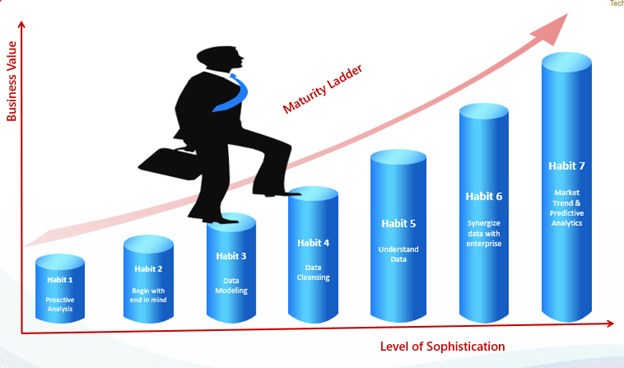
Data maturity journey is exciting for any enterprise. Enterprises may undergo challenges and rough tides in this journey when multiple systems exist with varied technologies. These systems can be legacy applications, ERP, external data sources, several tools and technologies generating data in differential forms. Categorization of these as ‘System of events’ and ‘System of records’ is a part of the journey. The journey involves building a modern data hub and requires organizations to develop standard habits or best practices. These are translated into a process for percolation across the enterprise. Such processes and best practices become a key element in the success of the digital initiatives. The following seven habits can act as a baseline in establishing this journey, which then can be refined further.
7 Habits of Data Management Strategy
1. Proactiveness: Proactive Analysis to understand the current situation, fit-gap analysis, and future direction can help in strategizing an improvement roadmap. This is a continuous process and has to be revisited at regular intervals to ensure accuracy and check the need for changes in data management.
Note: This may also volunteer the enterprise thought leaders to engage with external specialists (consultants) who can bring in a third dimension in resonating an out-of-the-box brain dump.
2. Begin with the end in mind: The whole purpose of any enterprise strategy depends on the ROI for the business. There needs to be a clear understanding of the business goals for creating a transparent enterprise from a data strategy perspective. This step enables the business to establish a road map for their future needs and in turn, enables IT to service better with seamless collaboration.
3. Data Modeling: Modeling a scalable data structure for an enterprise is a challenging task for the IT department of any organization. However, the value that this activity brings to the table is multi-fold:
- Standardization of data storage layer
- Clear domain understanding
- Build a performance-driven, high-quality and scalable storage layer
- Resilient adaptable to changes in the enterprise needs
4. Clean Data: Build a quality data hub for providing enterprise-wide single source of truth. Generally, this falls under master data activity. Strategizing a data solution to manage the enterprise golden record is needed for the digital transformation journey. Also, information truth, validity, interpretation, and insightful data form a key in making a strategic business decisions. Clean data drives one step towards this activity.
5. Understand your data: Seek first to understand, then to be understood. Forming a bridge between the enterprise data and the business is involved in this step. Understanding your data does not just limit what you have; this involves profound clarity on your business sentiments, needs, and future direction. Quite a bit of communication, collaboration, and stage setting form a key activity.
6. Data Governance and Synergizing: Data cannot be left in a silo. Synergizing and sharing the data knowledge across enterprise is vital. In most of the enterprises, this is where a huge gap exists where the business does not have any idea of what IT has in its enterprise data ecosystem. This gives birth to data duplication, which over a period, becomes difficult to manage. Data governance facilitates this activity and simplifies the data synergizing task. Some of the key activities that enables governance is as follows:
- Improvement prioritization
- Information availability
- Creation of RACI chart
- Detailing of rules, roles and responsibility
- Information integration
- Build a data dictionary, meta-data management strategy, and model strategy
- Process improvement suggestion and feedback
Note: This whole activity may involve external intervention like engaging with a professional consulting agency that can bring in world knowledge and experience into the organization
7. Market trend and building an analytics solution: Understand the market trends and react to the changing market demands. This needs to address the following three areas of analytics
- Descriptive Analytics – Used to process data into results readable at a glance. The first step towards analytics. This step involves an understanding of the existing enterprise data and unravels the information to give business insight.
- Predictive Analytics – Once we achieve some level of maturity in the first step, predictive analytics enables us to predict and provide measurement information for managers, executives including C-level executives to make informed decision. Steps need to incorporate mathematical and statistical models, machine learning techniques by way of understanding the prior pattern.
- Prescriptive analytics – Prescriptive analytics is dependent on the previous two steps and how well we achieved our goal. This step prescribes a specific course of action based on a descriptive, diagnostic, or predictive analysis, though typically the latter. This may need involvement of a highly business-driven mathematics savvy professionals and ‘Data Scientists’. The main ROI of this step is to get answers on the following:
- What’s happening (Understand the current situation)
- Why it happened (Address current situation)
- What will happen (Future vision)
- Advisory activity.
The key constraint what I observed in this activity so far are:
- Transferring that model into a production environment
- Establishing a feedback loop of data that keeps those models up to date
- Optimizing and improving on those models and redeploying them to a production environment once optimized.
Note: In most cases, this activity mandates a collaborative engagement between an Enterprise internal resource and an external consulting agency who can work together to bring in the right flavor and ROI to the overall data initiative.
YASH is available to help, please visit https://www.yash.com/digital-transformation/ for additional information or contact us .


















